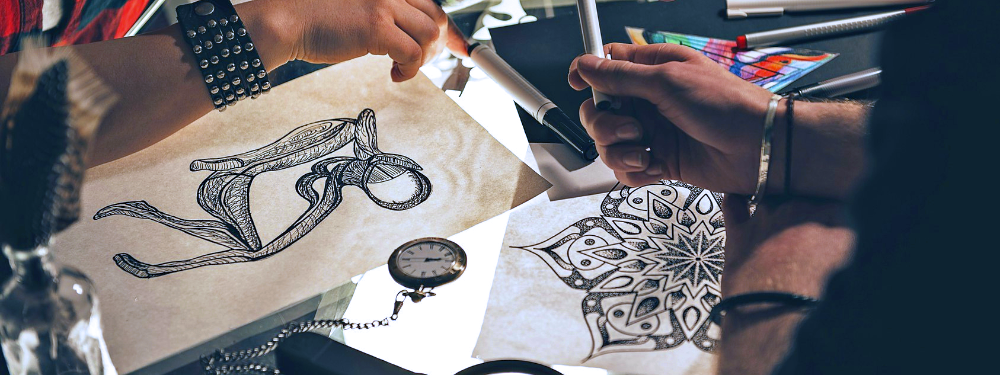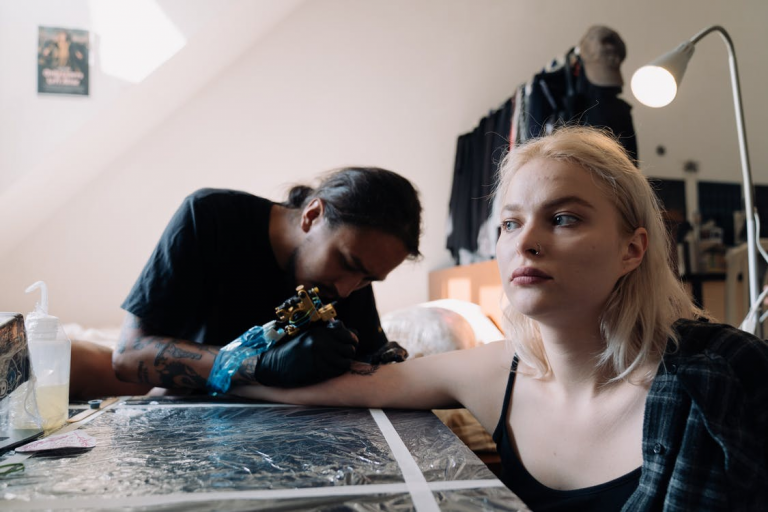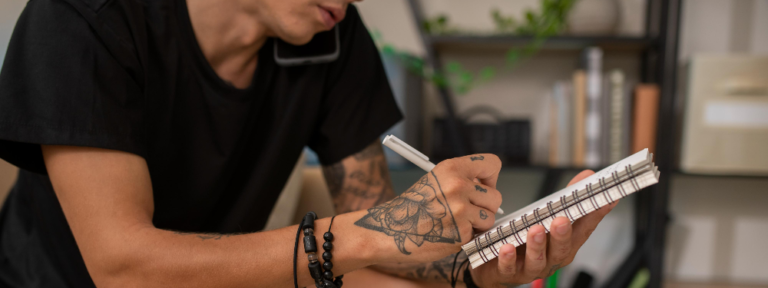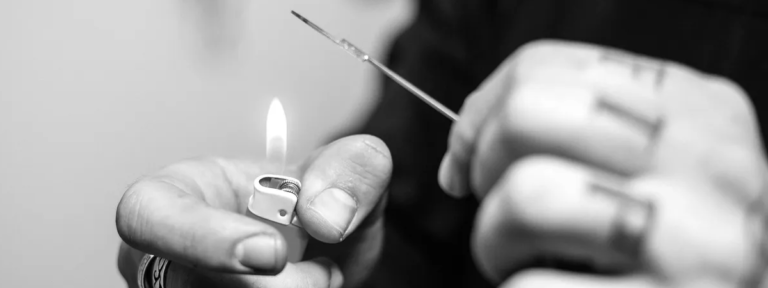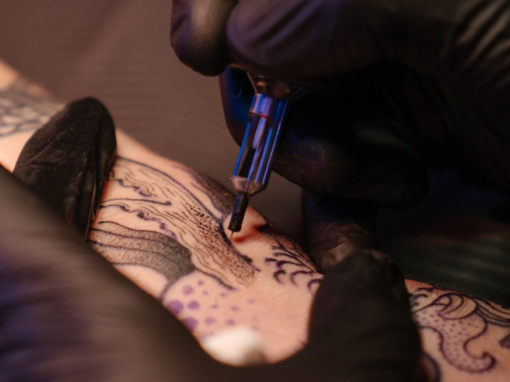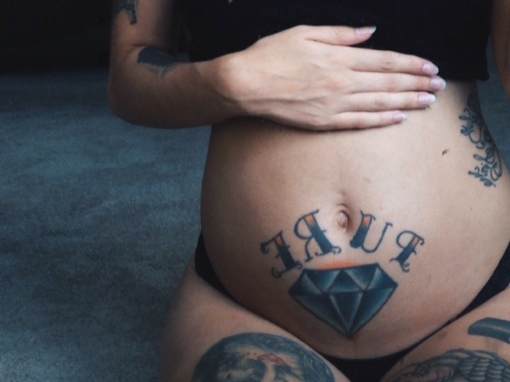Dreaming of becoming a tattoo artist? The first step is landing an apprenticeship, and that often hinges on one crucial element: your portfolio. Forget the myth that a physical portfolio is a relic of the past. In the world of tattooing, it’s still the gold standard for showcasing your skills and passion to potential mentors. So you need to get ready to show off your talents. We will, in turn, give tips on how to make a tattoo portfolio so that you have the best chance of getting the apprenticeship you want.
We’ll reveal the subtleties of building a physical and digital tattoo portfolio, what to include in it, break down stellar and subpar examples of tattoo artist portfolios, and share some advice for individuals who already have tattoo expertise and want to improve their portfolio.
There will be plenty of information, including samples and everything you’ll need, so stay tuned for more!
Why You Need a Tattoo Portfolio for Apprenticeship
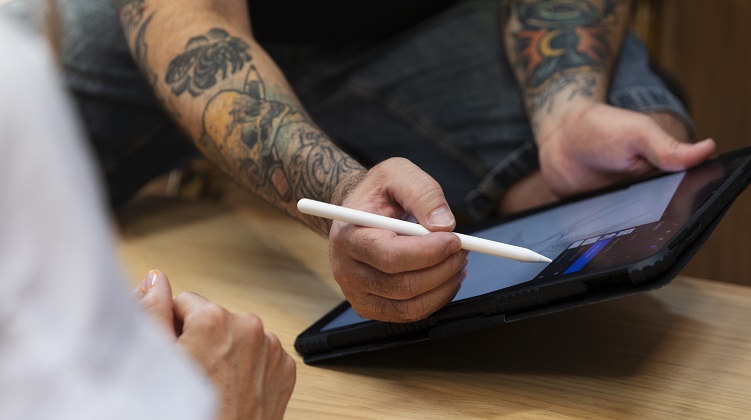
Tattoo apprenticeships are highly competitive, and your portfolio is the weapon you’ll use to stand out. Let’s break down why it’s so important.
Consider your tattoo portfolio as the key to obtaining the desired mentorship. Your portfolio, like a CV for regular employment, is a visual reflection of your artistic abilities and dedication. It enables possible mentors to analyze your skills in various styles, your linework precision, and, most significantly, your enthusiasm for the tattoo industry.
In a highly competitive market, a well-crafted portfolio allows you to stand out. It is more than just a collection of sketches; it demonstrates your awareness of how to portray yourself professionally and efficiently. Putting the proper pieces in your portfolio and carefully presenting them will increase your chances of landing the apprenticeship of your dreams.
How to Start a Tattoo Portfolio
Let’s say you’re ready to embark on your tattoo journey and want to find a mentor for training. You have your designs, but no instructions on how to organize and display them. The question arises: what to do? Where do you start?
First, decide on the format of your portfolio (physical or digital). Second, you’ll need to know what to include to demonstrate that you’re well-prepared and committed to your chosen career. Then, examine the following items and actions that may be useful in constructing your portfolio and make the process a little easier:
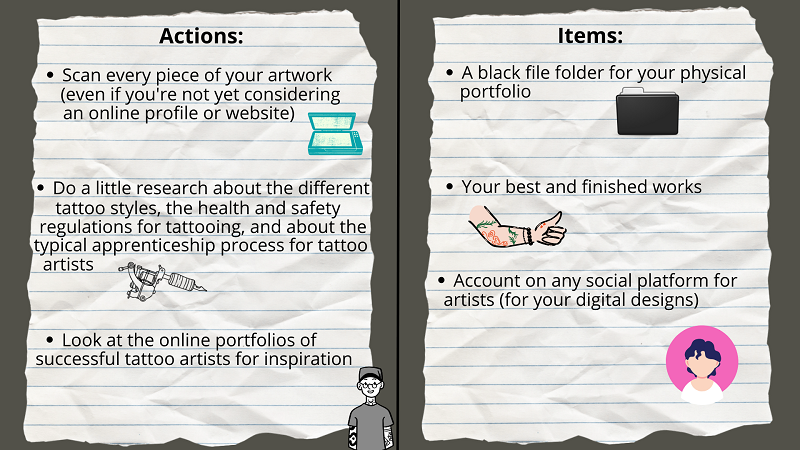
Things you will need to do to begin constructing your portfolio
What to Feature in Your Portfolio
A strong tattoo art portfolio is based on three key elements applicable to both physical and digital formats. Here are they:
- Section “About me”
Your future mentor is likely to look out for artists who present themselves. Write a professional biography of your artistic experience, preferred styles, and the length of your artistic career. Did you refine your skills in art school or develop them on your own? Share it! This brief introduction is your chance to make a positive first impression.
Consider adding your creative nickname (if you have one) to keep your online presence (website or Instagram) consistent.
- Choose your 30-70 best designs
“Less design but more refinement.” Choose the strongest pieces that showcase your artistic talent in a variety of styles. Think of them as gems of your art — choose them carefully to demonstrate your commitment and skill level.
- Different styles
Expand your artistic horizons and incorporate different popular tattoo styles within your portfolio. Explore 5-10 of the most sought-after styles and showcase your proficiency in each. Here are some popular styles to consider:

Here are featured works by our artists. You can see more of them in our gallery
And, of course, if you have your own style and ideas, you should include them in your portfolio.
The Ways to Showcase Your Work
Remember that tip about digitizing your artwork? This not only saves space in a physical portfolio but also allows for easy updates to both digital and physical versions in the future. Now, let’s take a closer look at portfolio formats and explore the different ways you can present your stunning designs!
Physical Portfolio
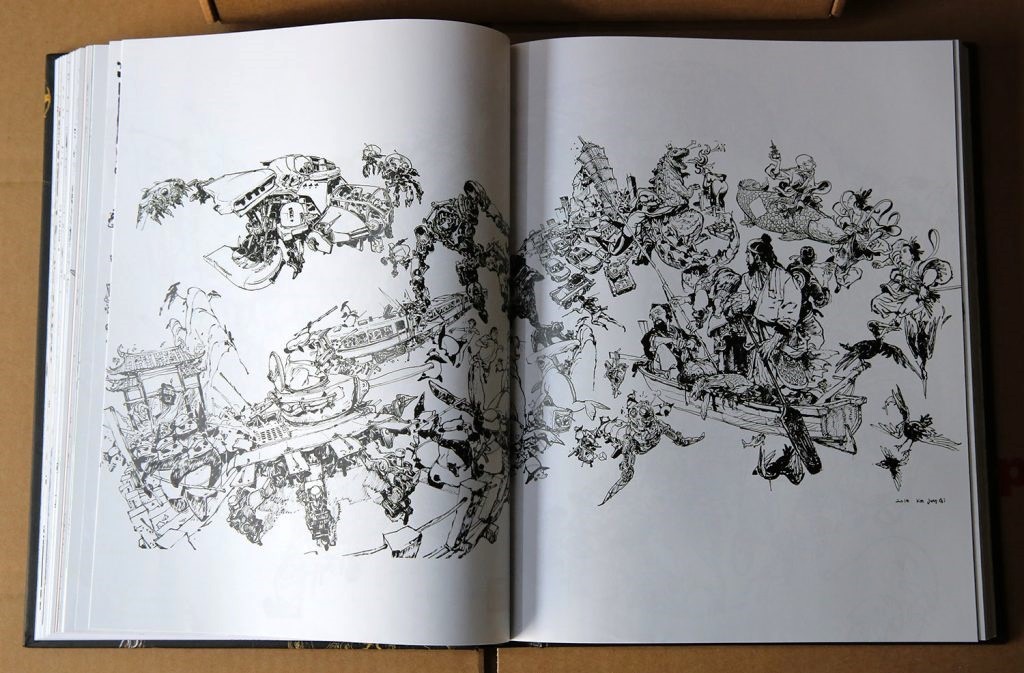
For those who prefer a hands-on approach, physical portfolios offer a classic way to present your work. There are two main options:
- ✍ Drawn portfolio
This format allows each piece to shine on its sheet of paper. This is ideal for showcasing individual designs. However, exceptions can be made for flash sheets (pre-designed tattoos often displayed in shops) or collections of designs that naturally belong together, like variations on a single theme.
- ? Hard copy portfolio
Take well-lit photos of your artwork. Natural light is ideal, but artificial lighting can work too, as long as it eliminates shadows and provides an even illumination.
Alternatively, scan your artwork. This allows for easy organization and potential digital editing to remove minor imperfections like stains or scuffs on the original sheet.
Digital Portfolio
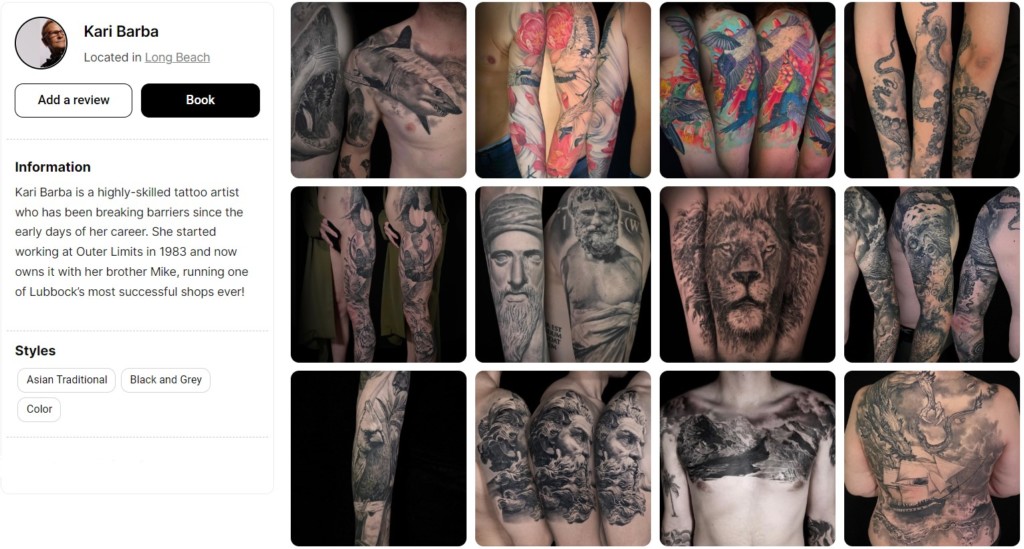
Kari Barba’s tattoo portfolio on the InkMatch website
In today’s digital age, your portfolio can go beyond or be an extension of your physical folder. Here are some ways to showcase your work online:
- Online platforms for portfolios
These artist-oriented websites offer pre-designed templates, easy customization tools, and features like client galleries (though less relevant for tattoo portfolios). Popular options include Behance, Dribble, or ArtStation.
- Social media account
Platforms like Instagram or Artfol can be a great way to build an online following and showcase your work. Use high-quality photos of your tattoo designs and mockups, along with relevant hashtags to reach potential mentors and clients.
- Cloud storage with a link
This is a simple option, but might not be the most visually appealing. You can upload your high-resolution portfolio images to a cloud storage service like Google Drive or Dropbox and then share a link to the folder with potential mentors. This ensures they can see all your work at once but lacks the design polish of a dedicated portfolio website.
- Our website
Ink-Match is a tattoo artist finder that can help people find the perfect artist for their next tattoo. Our site allows users to browse a list of artists by location or search for artists by style. This is a great resource for people who are looking for a talented tattoo artist.
If you already have a collection of photos of real-life tattoos, Ink-Match is a great way to showcase your work to potential clients. By creating a profile on the site, you can showcase your portfolio and let people know about your capabilities.
Dos and Don’ts When Creating a Portfolio
Your portfolio is your artistic calling card, the key that unlocks the door to your dream apprenticeship. Here’s a breakdown of essential dos and don’ts to ensure your portfolio makes a lasting impression:
| Things that will improve your portfolio | Things that will give a bad impression |
| ✅ For a physical portfolio, choose a professional black folder and high-quality, thick paper that won’t bleed through | ❌ A brightly colored folder might pull focus away from your designs |
| ✅ Showcase your 30-70 strongest, fully completed designs | ❌ Thin paper allows artwork on the back to show through, creating an unprofessional look |
| ✅ Include works in different popular tattoo styles to demonstrate your versatility | ❌ Cut out your designs and glue them on |
| ✅ If photographing your artwork, ensure well-lit images that capture all the details | ❌ Showcase your unfinished works |
| ✅ Present each piece on a separate sheet (except for flash sheets or thematically linked designs) | ❌ Limit yourself to one style |
| ✅ Include a dedicated “About Me” section that highlights your artistic journey, experience, and preferred styles | ❌ Forget the “About Me” section |
| ✅ Consider including your contact information and a link to your relevant social media profiles (like Instagram) where you showcase your work | ❌ Forgetting to include contacts or the name of a social media profile with your work |
| ✅ If you have already had experience in tattooing people and have photos of these works, add them |
Best Examples of Tattoo Portfolios
Ready for a glimpse into the world of winning presentations? We’ll show you a few tattoo artist portfolio examples that effectively demonstrate skill and dedication. By analyzing what makes them successful, you can make sure your collection of designs shines.

An example of a good physical tattoo apprenticeship portfolio

An example of a good digital tattoo apprenticeship portfolio
Bad Examples of Tattoo Portfolios
Not all portfolios are created equal. Here, we’ll explore four tattoo portfolio examples that might raise red flags for potential mentors. Understanding these pitfalls will help you craft a portfolio that avoids these common mistakes.

An example of a bad tattoo apprenticeship portfolio

An example of a bad tattoo apprenticeship portfolio
Tips for Established Apprentices
If you’re an apprentice who has already taken a great first step towards your tattoo career, here are some additional tips to help you continue to grow and develop:
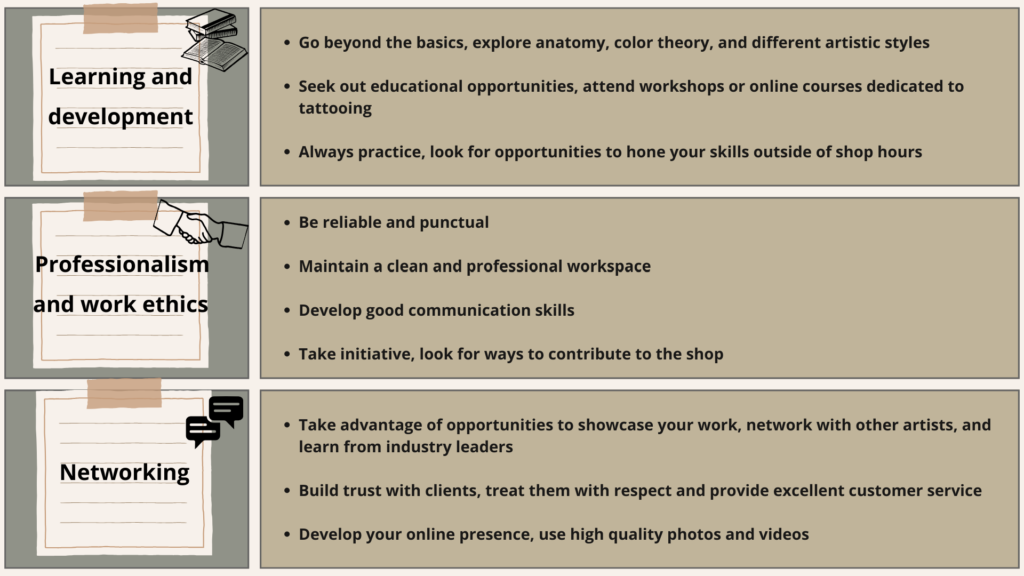
Tips for established apprentices
Summary
While finding the perfect mentor and building a standout portfolio can feel like climbing a mountain, you’ve now conquered the first peak! This guide has equipped you with all the essential steps, from crafting a compelling portfolio to analyzing successful examples. We hope that now you are armed with these insights, and know well how to make a tattoo apprentice portfolio that gets you noticed.
We wish you patience, as learning to tattoo takes time and dedication. Stay humble and enjoy your journey, as tattooing can be a rewarding career.
Good luck and inspiration to you!
FAQ
? Can a Tattoo Portfolio Be All Digital?
Of course, it’s a cool and convenient way to present your work. You may always carry it with you in whatever medium. However, if you intend to work as an apprentice at a tattoo studio in the future, you need to have a physical copy of your drawings because tattoo artists will look at it first.
? What Makes a Great Tattoo Portfolio?
A great tattoo portfolio should balance quality with variety. This means including well-lit close-up photos of your designs in different styles, from black and grey to color.
✍️ What Are the Essential Skills for Tattooing?
Beyond artistic ability, essential tattooing skills include precision for clean lines, hygiene knowledge to ensure safety, and good communication to understand client desires.
✨ How Do I Develop My Artistic Style?
Explore various tattoo styles, draw inspiration from other art forms, and practice regularly to refine your unique technique.
❓ What Should I Include in My Portfolio?
Focus on adding a section about yourself, 30-70 of your best designs, and also don’t forget to try different tattoo styles. As a side note, you can show your progress to a future mentor by redoing an old design, or showing your work from a year ago and now.
